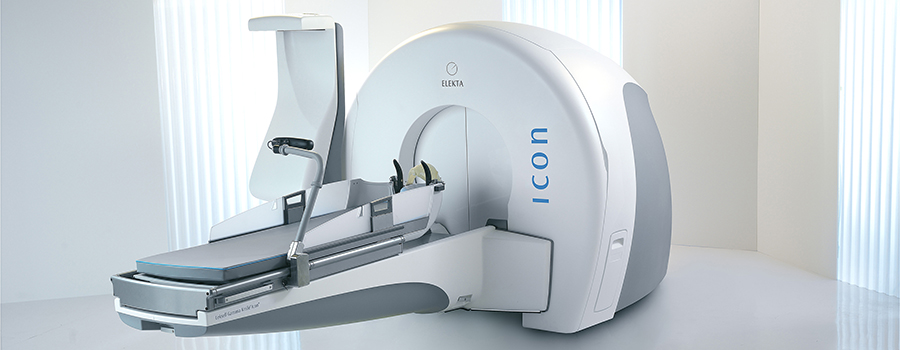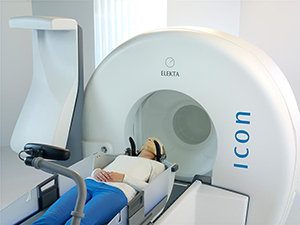Gamma Knife® is a treatment device with the ability to treat brain tumors, vascular malformations, and functional disorders (neurological pain and movement disorders) without the risks of open surgery such as general anesthesia, infection and bleeding. This treatment requires no cutting or incisions and can be especially useful for those patients who are not suitable for standard surgical techniques due to illness or advanced age. The Gamma Knife® uses 201 focused beams of radiation to deliver a highly therapeutic dose to a target with sub-millimeter precision. Recovery is quick, and the treatment is generally administered on an outpatient basis.
A multidisciplinary team including surgeons, radiation oncologists, and radiation physicists work together to generate an optimal treatment plan delivering a high dose of radiation to the target while sparing the surrounding normal brain.
Gamma Knife® can be used to treat:

Is there any preparation required for Gamma Knife Radiosurgery?
There is no special preparation required prior to your arrival at the Gamma Knife Center on the day of your treatment.
What happens during Gamma Knife Radiosurgery?
Upon your arrival at the Gamma Knife Center, the treatment team will explain the entire procedure in detail.
For accurate targeting, a frame is placed on your head. This helps the treatment team to pinpoint the target, prevents any movement during the procedure, and allows for maximal accuracy of the radiation beams. After you have received local anesthesia,
the frame is attached to your head with screws.
Detailed imaging studies (such as an MRI scan, CT scan, or angiogram) will then be performed allowing for the precise definition of the desired target (tumor or lesion) in the Gamma Knife treatment planning software.
Once imaging is complete, you will be taken to a quiet area where you may rest while your physicians and the remainder of the Gamma Knife team create your treatment plan. This will likely require one or two hours, as every treatment plan is unique and
optimized to the specific requirements of the individual patient. During this time, you may sleep, watch TV, read, visit with family, etc.
When the team has completed your treatment plan, it is time for treatment. No anesthesia is required, but you may be given medications to help you relax throughout the treatment. The Gamma Knife unit looks like a CT scan machine.
 You
will lie on a treatment couch, and the head frame will be attached to the appropriate treatment helmet. The helmet is the device used to focus the 201 radiation beams precisely on the target. The treatment itself is completely painless. The couch
smoothly slides into position in the Gamma Knife machine. You will be closely monitored during the procedure by video and will be in constant contact with the treatment team by an intercom connection. Most treatments will last between 20 and 90 minutes,
depending on your personalized plan.
You
will lie on a treatment couch, and the head frame will be attached to the appropriate treatment helmet. The helmet is the device used to focus the 201 radiation beams precisely on the target. The treatment itself is completely painless. The couch
smoothly slides into position in the Gamma Knife machine. You will be closely monitored during the procedure by video and will be in constant contact with the treatment team by an intercom connection. Most treatments will last between 20 and 90 minutes,
depending on your personalized plan.
What can you expect after treatment?
When treatment is over, your doctor will remove the head frame. Some patients may experience swelling or mild headache where the frame is attached, but this is relatively rare. Depending on what your doctor feels appropriate, you may have to stay in hospital
for several hours or, rarely, overnight for observation.
Gamma Knife® radiosurgery exerts its effects over time. Your doctor will discuss with you the optimal way to determine the success of the procedure. Since this treatment is designed to stop the growth, shrinking or eliminate tumors/lesions, additional
MRI or CT scans may be required in the weeks to months following Gamma Knife® Radiosurgery.
Is this treatment covered by insurance?
Many insurance companies cover Gamma Knife Radiosurgery, but it is advisable to call your insurance company (using the number on the back of your card) to ensure that your treatment will be covered.
Gamma Knife Physicians
These physicians have completed the Elekta Gamma Knife training course, underwent documented proctoring for at least 3 cases (or met prior case volume experience requirements), and were approved for Gamma Knife Privileges by the Gamma Knife Oversight Committee and Corewell Health William Beaumont University Hospital Credentialing & Qualifications (C & Q) Committee.